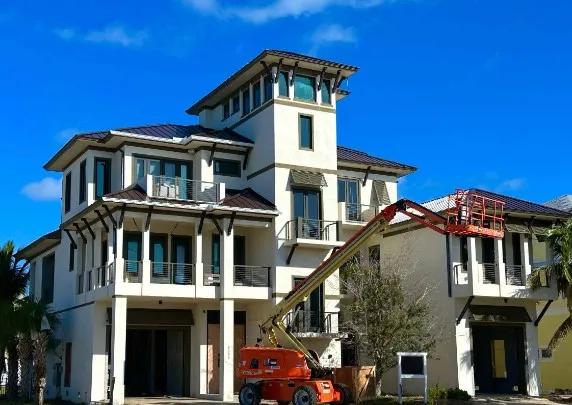Creating an Impenetrable Barrier with Resistant Materials Against Hurricane Forces
When Hurricane Michael struck the Florida Panhandle as a Category 5 storm in 2018, it demonstrated the devastating power of flying debris and extreme winds. Homes that survived intact shared common characteristics: impact-resistant materials and advanced building envelope systems that maintained structural integrity under extreme conditions. When properly implemented, modern design, engineering, and construction can afford homeowners unprecedented protection against hurricane forces.

Impact-Resistant Windows and Doors: Your Home’s Critical Defense
Impact-resistant windows represent one of the most important investments you can make in hurricane protection. These engineered systems prevent flying debris from entering your home and maintain the critical pressure envelope that keeps your roof attached. Standard windows failing during hurricanes often trigger catastrophic roof failure due to internal pressurization.
The technology behind impact resistance involves laminated glass similar to automotive windshields, but significantly stronger. Multiple layers of glass and polymer interlayers create a system that may crack but won’t shatter or allow penetration. Testing standards require these windows to withstand impacts from 2×4 lumber traveling at 50 feet per second, simulating typical hurricane debris.
Impact-resistant doors must meet similar standards while providing the additional challenge of larger openings and more complex hardware. French and sliding glass doors represent particular challenges, but modern systems provide hurricane protection without sacrificing aesthetics or functionality. Proper installation is crucial—even the best impact-resistant door fails if not properly anchored and sealed.
Advanced Roofing Systems: Engineering Above the Storm
Metal roofing systems have revolutionized hurricane protection for coastal homes. When properly installed, standing seam metal roofs can withstand winds exceeding 150 mph. The continuous attachment system and lack of individual shingles eliminate the progressive failure mode common with traditional roofing materials.
Structural roofing panels that serve as both sheathing and finish material provide exceptional strength and weather protection. These panels eliminate the multiple layers typical of traditional roofing systems, reducing failure points and simplifying installation. Proper attachment spacing and fastener selection are critical for performance under extreme loads.
Cool roof technology provides additional benefits beyond hurricane resistance. Reflective coatings and colors reduce heat absorption, lowering cooling costs and extending material life. In hurricane-prone areas, these systems must maintain their reflective properties even after exposure to flying debris and extreme weather.
Engineered Wall Systems: Strength Through Integration
Insulated concrete forms (ICF) represent the gold standard for hurricane-resistant wall construction. These systems combine structural concrete with integral insulation, creating walls that can withstand extreme winds while providing superior energy efficiency. ICF walls have repeatedly demonstrated their ability to survive direct hits from major hurricanes.
Structural insulated panels (SIPs) offer another approach to high-performance wall systems. These engineered panels combine structural sheathing with foam insulation cores, creating walls stronger than traditional stick-frame construction. Proper connection details are crucial for SIP systems to achieve their full structural potential.
Steel stud framing with appropriate sheathing provides excellent hurricane resistance at a more moderate cost. Cold-formed steel studs don’t warp, shrink, or rot, maintaining structural integrity under extreme conditions. The key is proper connection details and appropriate sheathing materials that work together as a system.
Advanced Moisture Management Systems
Hurricane-resistant building envelopes must handle extreme water intrusion while drying quickly after storm passage. Advanced vapor barriers and drainage systems prevent long-term moisture problems that can destroy homes from the inside out. These systems become critical in the high-humidity environment following major storms.
Rainscreen systems create a drainage plane behind exterior cladding that allows water to drain away from the structure. This technology prevents wind-driven rain from penetrating the building envelope while allowing any moisture that does penetrate to escape safely. Proper detailing at openings and penetrations is crucial for effectiveness.
Flashing systems designed for extreme weather conditions protect vulnerable transitions and penetrations. Self-adhering membranes and liquid-applied systems offer superior performance compared to traditional metal flashing, especially in high-wind conditions where mechanical fasteners can fail.
Exterior Cladding Systems: Beauty and Protection Combined
Fiber cement siding provides excellent hurricane resistance while offering the appearance of traditional wood siding. These products won’t rot, warp, or provide food for insects while maintaining their appearance under extreme weather conditions. Proper installation techniques prevent water intrusion while allowing for thermal movement.
Stucco systems, when properly designed and installed, provide excellent hurricane resistance. Three-coat systems over appropriate substrates create durable, weather-resistant exteriors that can handle flying debris. Proper mesh reinforcement and quality workmanship are essential for long-term performance.
Brick and stone veneer systems require special attention to anchoring and flashing details. These materials provide excellent impact resistance but must be properly supported and drained to prevent failure during extreme weather. Modern anchoring systems provide superior performance compared to traditional methods.
Integrated System Approach: The Whole is Greater Than the Parts
The most effective hurricane-resistant homes treat all envelope components as an integrated system. Windows, doors, walls, and roofing must work together to maintain structural integrity and prevent water intrusion. The failure of any single component can compromise the entire system.
Quality control during construction ensures all systems perform as designed. Regular inspections during installation verify proper techniques and materials. Even the best materials fail if not properly installed according to the manufacturer’s specifications and local building codes.
Testing and commissioning of building envelope systems before occupancy identifies potential problems before they become critical failures. Blower door testing, water testing, and thermal imaging can reveal issues that might not be apparent during visual inspection.
Maintenance and Long-Term Performance
Regular maintenance schedules preserve the performance of impact-resistant materials and advanced envelope systems. Annual inspections identify potential problems before they compromise your home’s protection. Professional maintenance ensures warranty coverage remains valid and systems perform as intended.
Weather monitoring systems provide early warning of conditions that might affect your home’s envelope systems. Smart sensors can detect water intrusion, pressure changes, or other conditions that require immediate attention. These systems provide peace of mind and early intervention capabilities.
Upgrade planning keeps your home’s protection systems current with changing technology and building codes. As new materials and techniques become available, strategic upgrades can improve your home’s performance while maintaining reasonable costs. Professional consultation ensures upgrades integrate properly with existing systems.
Investment Returns and Value Creation
Impact-resistant materials and advanced envelope systems provide returns through reduced insurance premiums, lower maintenance costs, and improved energy efficiency. Insurance companies increasingly recognize and reward hurricane-resistant construction through significant premium discounts.
Property values reflect the advantages of superior construction in hurricane-prone areas. Homes with documented hurricane-resistant features often command premium prices and sell faster than comparable properties. The investment in advanced systems pays dividends in both protection and marketability.
Energy efficiency benefits from advanced envelope systems provide ongoing savings that compound over time. Properly designed systems reduce heating and cooling costs while maintaining comfort even during extreme weather events. These savings help offset the initial investment in superior materials and construction techniques.

